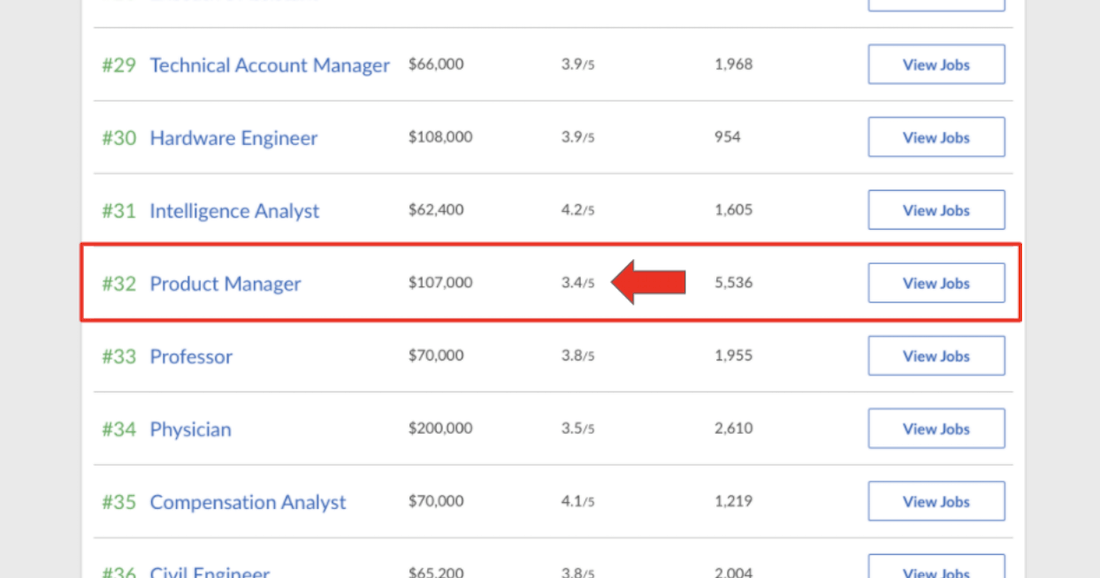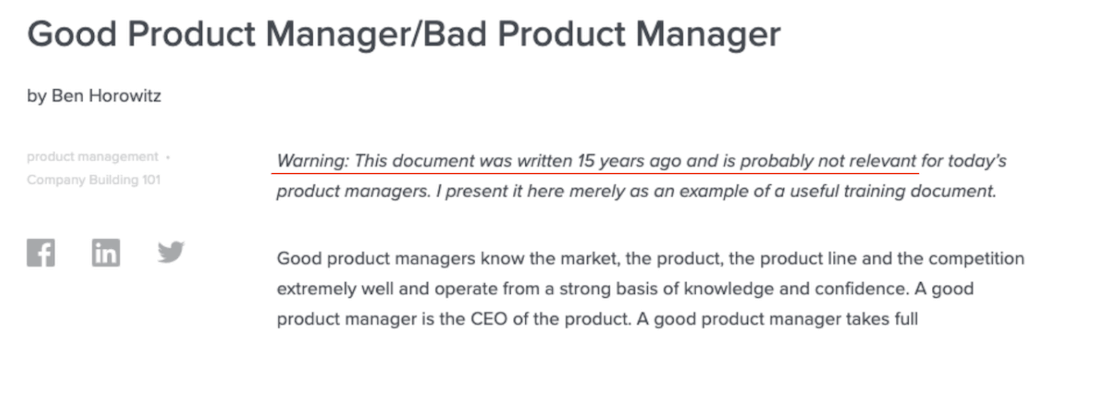In 2017, I came across GlassDoor’s top 50 jobs. Like we all do, I first looked for my own role. I scrolled to “product manager” and was happy to see the job on the list next to a nice six-figure average salary. But then I saw the job satisfaction: 3.4. As I scrolled through the entire list of 50 jobs, I realized this was the lowest satisfaction of all of them.

I went through a quick grief cycle:
- Denial: “No, that can’t be right. Product management is the best job ever.”
- Anger: “My job wouldn’t be so hard if sales would stop asking for so much and eng would just build what we ask for the first time.”
- Bargaining: “Maybe I should just have engineers build whatever the customers want.”
- Depression: “Man, my job really stinks.”
- Acceptance: “Ok, this is a stressful job. What am I going to do about it?”
The harsh reality? Product management is a hard job.
Many people don’t realize how stressful product management can be. In fact, most product managers I have frank conversations with are unhappy and stressed out.
Past research completed by Pendo also supports this sad truth. In their 2019 State of Product Leadership report, they shared that their survey respondents gave the job an NPS of 3. Apparently, this problem is quite widespread throughout the PM field.
So, why is a product manager’s job so hard? Here are just a few of the reasons:
- You’re frustrated and stuck because leaders and stakeholders aren’t aligned
- You feel like you can’t make progress because priorities keep changing
- Decision-making feels impossible because you’re trying to appease everyone
- You (and your team) get burnt out from shipping features that don’t seem to create the desired change
- All of these only add to your stress, pressure, and (for too many) hopelessness.
Getting and keeping teams aligned, carving out space and patience to explore, understanding what people really want, and delivering value worth paying for are all difficult to achieve.
And when all of this is executed poorly, teams take too long and end up building the wrong thing. This leads to a vicious cycle of reducing team autonomy, which only leads to more of these same outcomes. Combine these mental stressors with the tedious work you can find yourself stuck with, and the job becomes a drag.
How can you make product management less stressful?
So, how do we even start to make this better? If you’re experiencing these stressors, here are three things you can do to change your mental operating system.
- Plan to fail
- Accept that scrum doesn’t work
- Realize you aren’t the CEO of the product
1. Plan to fail
Most of your ideas are bad. In fact, the best teams assume this out of the gate. Armed with this knowledge, teams change the way they operate and communicate. If most of what you produce will fail, you’d better figure out how to learn quickly what will and won’t flop.
However, timeline-driven feature development is a classic sign of not planning to fail. Design sprints are popular because they take you from conjecture to actual prototype in the hands of real users in just a few days. But the goal isn’t to hit a deadline. It’s to learn.
This is less like planning a known route for a road trip (which you can predict with reasonable certainty) and more like playing a game of poker. If I asked you to predict which hands you will bet on and which you will fold on before the game starts, you won’t have a clue.
Like product management, poker is a game of probabilistic thinking. As information changes, you adjust your actions. You learn throughout the game. Your role as a product manager is to help your team place the right bets and fold when needed.
2. Accept that scrum doesn’t work
The way we measure success on many product teams isn’t helping. For too many, agile = scrum. And sadly, scrum has created well-intentioned but ultimately poor measures of success. Story points, velocity, burn down … it’s too easy for teams to make the meetings and shipping the focus.
When outputs (rather than outcomes) become your main measure of success, you’ll find a number of poor practices:
- Decreased autonomy
- Decreased creativity
- PM as order taker — “Build this”
- Changes without impact
- Wasted time, money, and energy
Scrum can be used well, but it’s just one tool among many. To avoid some of these pitfalls, ensure you have a proper product roadmap (that isn’t just a Gantt chart of features). Also, focus more on the values of agile product management than on the mechanics of scrum.
3. Realize you aren’t the CEO of the product
The article in which Ben Horowitz made famous the idea that a good product manager is the CEO of the product has been updated. Here’s what it says now:

The man who coined the phrase openly acknowledges that it probably isn’t relevant for product management today. So why does this myth persist?
Many are attracted to product management from the siren song of power. “If I’m the CEO of the product, I get to call the shots.” Unfortunately, that’s rarely, if ever, true. This leads to unmet expectations and frustrating experiences. I personally was nearly fired for failing to understand this early in my career.
Also, the “product manager as the CEO” myth has attracted a number of arrogant PMs to the field. As teams realize that concepts like leadership exchange and true collaboration are not only possible but extremely effective, arrogance becomes more and more of a hindrance
But if you aren’t the CEO of the product, then what are you?
You’re more like a pirate captain or American football quarterback. After all, product is a team sport. You don’t have complete control. You have to get buy-in and work with and through others using influence without authority. While you do call some of the plays, you don’t call all of them. And sadly, you are often blamed when things go wrong.
Unlike a CEO, you don’t manage the budget or the team, and you can’t hire or fire whoever you want. And you normally have many other stakeholders and leaders who have to buy in or sign off on your decisions.
This is the single biggest issue causing angst for product managers and product teams. It doesn’t matter how good your idea is if no one wants to follow you.
This is true for internal teams (developers, designers) as well as customers. It’s less about being right and more about bringing people along.
—
Product management doesn’t have to be a stressful job. When you understand your role (quarterback, not CEO), use a good mental model for product development (agile mindset, not just scrum), and plan to fail (probabilistic thinking vs. believing everything has to be a home run), then you are set up to deliver real value without burning out.

